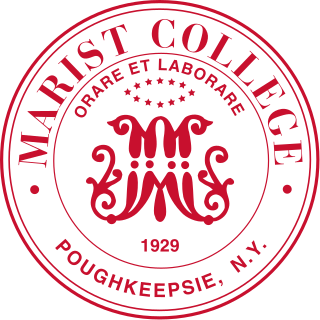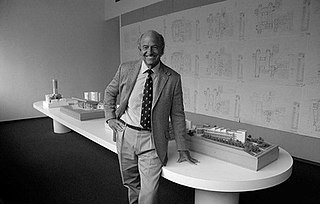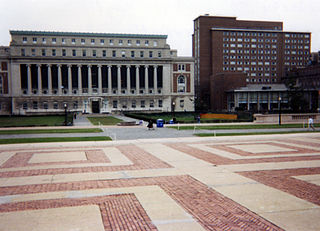History
An earlier plan for East Campus (1965), by Harrison and Abromowitz architects, included twin concrete slab towers. [2] Along with the rest of the ambitious expansion plans of University President Grayson L. Kirk, it was scrapped in the wake of the 1968 protests against, among other things, a university gym proposed for nearby Morningside Park. When expansion finally did reach East Campus, by the late 1970s, the university was seeking a more humanist design, one which would both harmonize better with the surrounding campus and reflect, to some degree, the residential college quads of Oxford and Yale.
When East Campus opened, students appreciated its expansive suite space, commanding views, and spacious townhouses, which were a relieving contrast to cramped conditions in much of the rest of the university's housing. Many of the outer townhouses were donated and built by famous Columbia University benefactors. The most notable of these is Thomas J. Watson, Jr. who donated the popular Watson House. Donor George Delacorte, for whom the building's central courtyard is formally named, said of his former room at the university "we had two nails on the wall for a closet...now I've paid for a dormitory where boys loll around in marble bathtubs." The bathrooms are not, however, actually marble, but imitate that material. [3]
The main high-rise building was named Hudson Hall, named after prominent stockbroker Percy K. Hudson (1877–1962), who was married to actress Vida Whitmore. [4] [5]
On October 10, 1985, a Columbia engineering student, Sarah M. Thomas, was stabbed in her East Campus suite by an intruder, a man who had been signed in as a guest by another resident. It was one of a number of violent crimes in the Columbia dormitories during the 1980s. [6]
An inspection in 1987 revealed that the tiled exterior which had earned the building accolades had begun to peel off its facade, and a large chunk collapsed into its courtyard in February 1988, prompting the university to order its recladding, a $15 million project handled by the architects Gruzon Sampton Steinglass, in the campus' traditional red brick and limestone. In the course of the scandal, Columbia sued both Gwathmey Siegel and the engineering firm that had worked on the project. [7]
In 2006, a homophobic message written on a dry-erase board in East Campus was denounced as a hate crime, the sixth one alleged that year, and prompted the creation of the controversial student group Stop Hate on Columbia's Campus (SHOCC).

Morningside Heights is a neighborhood on the West Side of Upper Manhattan in New York City. It is bounded by Morningside Drive to the east, 125th Street to the north, 110th Street to the south, and Riverside Drive to the west. Morningside Heights borders Central Harlem and Morningside Park to the east, Manhattanville to the north, the Manhattan Valley section of the Upper West Side to the south, and Riverside Park to the west. Broadway is the neighborhood's main thoroughfare, running north–south.

Marist College is a private university in Poughkeepsie, New York. Founded in 1905, Marist was formed by the Marist Brothers, a Catholic religious institute, to prepare brothers for their vocations as educators. By 1969, the college had become private with a predominantly lay board of trustees and in 2003, the Catholic Church recognized Marist as a secular institution.

Columbia College is the oldest undergraduate college of Columbia University, a private Ivy League research university in New York City. Situated on the university's main campus in Morningside Heights in the borough of Manhattan, it was founded by the Church of England in 1754 as King's College by royal charter of King George II of Great Britain. It is Columbia University's traditional undergraduate program, offering BA degrees, and is the oldest institution of higher learning in the state of New York and the fifth oldest in the United States.
Columbia University in New York City has an extensive tunnel system underneath its Morningside Heights campus connecting many of its buildings, used by the university as conduits for steam, electricity, telecommunications, and other infrastructure. Throughout their history, the tunnels have also been used for other purposes, mostly centering around transportation. During the first half of the 20th century, they were used by students to avoid aboveground traffic. When the university housed the Manhattan Project, they were allegedly used to move radioactive material between buildings. During the Columbia University protests of 1968, students used the tunnels to facilitate their occupation of buildings on campus.

Charles Gwathmey was an American architect. He was a principal at Gwathmey Siegel & Associates Architects, as well as one of the five architects identified as The New York Five in 1969. Gwathmey was perhaps best known for the 1992 renovation of Frank Lloyd Wright's Guggenheim Museum in New York City.
In 1968, a series of protests at Columbia University in New York City were one among the various student demonstrations that occurred around the globe in that year. The Columbia protests erupted over the spring of that year after students discovered links between the university and the institutional apparatus supporting the United States' involvement in the Vietnam War, as well as their concern over an allegedly segregated gymnasium to be constructed in the nearby Morningside Park. The protests resulted in the student occupation of many university buildings and the eventual violent removal of protesters by the New York City Police Department.

Manhattanville is a neighborhood in the New York City borough of Manhattan bordered on the north by 135th Street; on the south by 122nd and 125th Streets; on the west by Hudson River; and on the east by Adam Clayton Powell Jr. Boulevard and the campus of City College.

Rudolph Hall is one of the earliest and best-known examples of Brutalist architecture in the United States. Completed in 1963 in New Haven, Connecticut, the building houses Yale University's School of Architecture. Until 2000, it also housed the School of Art.

John Jay Hall is a 15-story building located on the southeastern extremity of the Morningside Heights campus of Columbia University in New York City, on the northwestern corner of 114th St. and Amsterdam Avenue. Named for Founding Father, The Federalist Papers author, diplomat, and first Chief Justice of the United States Supreme Court John Jay, it was among the last buildings designed by the architectural firm of McKim, Mead & White, which had provided Columbia's original Morningside Heights campus plan, and was finished in 1927.

Hamilton Hall is an academic building on the Morningside Heights campus of Columbia University on College Walk at 1130 Amsterdam Avenue in Manhattan, New York City, serving as the home of Columbia College. It was built in 1905–1907 and was designed by McKim, Mead & White in the Neoclassical style; the building was part of the firm's original master plan for the campus. The building was the gift of the John Stewart Kennedy, a former trustee of Columbia College, and is named after Alexander Hamilton, who attended King's College, Columbia's original name. A statue of Hamilton by William Ordway Partridge stands outside the building entrance. Hamilton Hall is the location of the Columbia College administrative offices.

Butler Library is located on the Morningside Heights campus of Columbia University at 535 West 114th Street, in Manhattan, New York City. It is the university's largest single library with over 2 million volumes, as well as one of the largest buildings on the campus. It houses the Columbia University Libraries collections in the humanities, history, social sciences, literature, philosophy, and religion, and the Columbia Rare Book and Manuscript Library.

Hartley Hall was the first official residence hall constructed on the campus of Columbia University's Morningside Heights campus, and houses undergraduate students from Columbia College as well as the Fu Foundation School of Engineering and Applied Science. The building is named for Columbia alumnus Marcellus Hartley Dodge, who donated $300,000 for its construction shortly after his graduation. The building was meant as a memorial to his grandfather, Marcellus Hartley, the owner of Remington Arms, who died during Dodge's sophomore year and who bequeathed him the family fortune. Dodge hoped to create “the commencement of a true dormitory system" at Columbia.

Wallach Hall is the second oldest residence hall on the campus of Columbia University, and currently houses undergraduate students from Columbia College as well as the Fu Foundation School of Engineering and Applied Science.

Morris A. Schapiro Hall, popularly known as Schapiro, is an undergraduate residence hall of Columbia University. The building is named after investment banker Morris Schapiro, who oversaw the merger of Chase Bank and Bank of Manhattan as well as the Chemical Bank and New York Trust Company.

Hogan Hall is a dormitory of Columbia University primarily reserved for fourth-year undergraduate students. The dorm is popular for its suite configurations as well as its central location. Built in 1898 as a nursing home, the building was converted to graduate student housing in 1977. It was named after Frank S. Hogan. It was converted into an undergraduate residence in 1994, then renovated in 2000 with the completion of a new entrance connecting it to Broadway Hall, designed by Robert A.M. Stern Architects. Located at the corner of 114th Street and Broadway in the Manhattan neighborhood of Morningside Heights, the building is named for former New York District Attorney Frank Hogan.
Broadway Residence Hall is a postmodern dormitory at Columbia University in New York City. The building is commonly referred to by students as "Broadway". The building is nominally located at the corner of Broadway and 113th Street, though it shares its main entrance, which opens onto 114th Street, with Hogan Hall. Designed by Robert A.M. Stern Architects, it opened in 2000. Originally supposed to blend with the redbrick McKim, Mead & White buildings of the Columbia campus, Broadway Hall's design was changed to placate neighbors who wished to see it blend with local apartment buildings. In addition to housing students, its lower levels are home to a hardware store and a branch of the New York Public Library system.

Carman Hall is a dormitory located on Columbia University's Morningside Heights campus and currently houses first-year students from Columbia College as well as the Fu Foundation School of Engineering and Applied Science.

Columbia University has developed many traditions over its 270-year-long existence, most of them associated with its oldest undergraduate division, Columbia College.
Gwathmey Siegel Kaufman & Associates Architects LLC is a New York City-based architectural firm founded in 1967 by architects Charles Gwathmey and Robert Siegel.

Buell Hall is an academic building on the Morningside Heights campus of Columbia University in New York City. Built in 1885 as Macy Villa, it is the oldest building on Columbia's campus, and the last remaining building at Columbia which dates back to the Bloomingdale Insane Asylum, on whose grounds the university is now located. It now houses La Maison Française, the oldest French cultural center on an American university campus, as well as the Temple Hoyne Buell Center for the Study of American Architecture of the Columbia Graduate School of Architecture, Planning and Preservation.



















